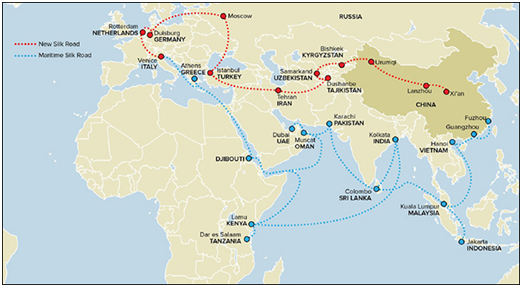

Context
China’s internationalization—as laid out its Belt and Road Initiative—is not simply a pursuit of geopolitical influence but also, in some tellings, a weapon, which can be even riskier for India.
Thus it becomes essential to have a definitive analysis of multiple aspects of the BRI.
Background
- China’s Belt and Road Initiative (BRI), launched in 2013 by President Xi Jinping during official visits to Kazakhstan and Indonesia, is among the world’s most ambitious infrastructure projects ever conceived.
- It is a union of development and investment initiatives that would stretch from East Asia to Europe, and in the process significantly expand China’s economic and political influence in these massive regions.
- Belt and Road, or yi dai yi lu, is a “21st century silk road,” confusingly made up of a “belt” of overland corridors and a maritime “road” of shipping lanes.
- The plan, initially named ‘One Belt, One Road’, is two-pronged:
- Overland Silk Road Economic Belt: On land, Beijing aims to connect the country’s underdeveloped hinterland to Europe through Central Asia.
- Maritime Silk Road: The maritime component will build ports and railways to connect the fast growing Southeast Asian region to China’s southern provinces and beyond till Europe via Middle East and East Africa.

Analysis
What is the ‘actual aim’ of China through BRI?
- Strengthening economic leadership: Viewed from the geopolitical lens, Beijing’s aim, through the BRI, is to strengthen its economic leadership.
- Asserting presence at global level: While gaining political leverage over its neighbours, China aims to assert its presence on the global stage. It runs parallel to China’s growing assertiveness in its bilateral relations, as seen in its increasingly hawkish actions in its immediate region, like South China Sea and beyond.
- Expansion of Chinese currency: It further aims to create a vast network of railways, energy pipelines, highways, and some 50 special economic zones—all of which would expand the international use of Chinese currency, the
Is China trying to ‘re-engage’ its ties?
- The BRI, however, is not only an initiative; it is a response: for one, to former US President Barack Obama’s ‘pivot to Asia’; and to the growing salience of the Indo-Pacific maritime geography as well.
- In recent years, the Indo Pacific has become central to the security and foreign policies of countries like the US, Japan, Australia, India, the UK, France, Germany, and the countries of ASEAN.
- China is working to strengthen global economic links to its western regions, which historically have been neglected.
- Promoting economic development in the western province of Xinjiang, where the Communist Party of China has waged a brutal campaign of intimidation and violence against the Uighur Muslims, is seen as a priority.
- So is securing long-term energy supplies from Central Asia and the Middle East.
Why is the initiative sparking global concern?
As Belt and Road raises various concerns for countries around the globe.
- Economic imperialism: It is a form of economic imperialism that gives China too much leverage over other countries, often those that are smaller and poorer.
- Expanding military presence: Some worry expanded Chinese commercial presence around the world will eventually lead to expanded military presence.
- In 2016 China established its first overseas military base in Djibouti. Analysts say almost all the ports and other transport infrastructure being built can be dual-use for commercial and military purposes, called militarization of supply chain.
|
What is India’s say in the project?
|
Is the plan becoming a debt trap?
China has often been accused of a non-transparent financing model for BRI, which has led to a debt trap in certain countries due to Chinese loans offered for the BRI projects.
The affected nations – Djibouti, Kyrgyzstan, Laos, the Maldives, Mongolia, Montenegro, Pakistan and Tajikistan – are among the poorest in their respective regions and will owe more than half of all their foreign debt to China.
- The story of Sri Lanka, for example, being saddled by the burden of unsustainable debt to China is well-documented. In 2018, former Malaysian President Mahathir Mohamad suspended work on certain BRI ventures in his country over concerns of mounting debts to China.
- For similar reasons, the government of Myanmar has significantly scaled down the Kyaukpyu port project.
- In Pakistan, too, the voices against the conditionalities tied to Chinese activities and loans have grown louder.
Major initiatives by other countries (to counter China’s BRI)
- Asia-Africa Growth Corridor: Japan, along with India has unveiled their own development cooperation with third countries under the banner of the Asia-Africa Growth Corridor.
- US International Development Finance Corporation (USIDFC): The US, meanwhile, has launched a new development finance institution, the US International Development Finance Corporation (USIDFC) to compete with the Asian Infrastructure Investment Bank(AIIB), headquartered in Beijing, China, which substantially finances BRI.
- Blue Dot Network: And the US and Australia have joined Japan in announcing plans through the Blue Dot Network for an alternative to BRI.
- Led by the USIDFC, the Blue Dot network was jointly launched by the US, Japan (Japanese Bank for International Cooperation) and Australia (Department of Foreign Affairs and Trade) in November 2019 on the sidelines of the 35th ASEAN Summit in Thailand.
- It is meant to be a multi-stakeholder initiative that aims to bring governments, the private sector and civil society together to promote “high quality, trusted standards for global infrastructure development”.
- However, there is not financing component involved in this.
Conclusion
In this era of global politics when Chinese belligerence is heightening alongside its expanding global footprint, countries around the globe, especially India must recognize how this Chinese initiative is aiming to reshape the global order in fundamental ways. Such knowledge and understanding would serve as an anchor for an appropriate response to China.

